Types of Products
Free download with code ToneBaseFree (Digital)
Choral Booklet (Print)
Full Score in 3 volumes (Print)
Anthology edition (Print)
Choral Score (includes 4 copies) (Print)
Full Score/Performance Score (4 required for performance) (Print)
Full Score/Performance Score (4 required for performance) (Digital)
solo part and piano reduction (Digital)
solo part and piano reduction (Print)
Full Score/Performance Score (6 scores required for performance) (Digital)
Performance Score (includes 4 scores) (Print)
Choral Scores (Digital - Bulk Purchase for Performance) (Digital)
This price covers the minimum cost of digital copies for performance.
Choral Score Set (Digital)
Choral Score Set (16 copies) (Digital)
Choral Score Set (License for 16 copies) (Digital)
Full Score/Performance Score (5 scores required for performance) (Digital)
Pricing reflects cost of 5 digital scores.
Full Score/Performance Score (8 scores required for performance) (Print)
Full Score/Performance Score (5 copies required for performance) (Print)
Vocal Score - single copy (Digital)
Vocal Score - license for single copy (Digital)
Vocal Score Set - 16 copies (Digital)
Vocal Score Set - License for 16 copies (Digital)
Vocal Score Set - 16 copies (Print)
Score (Digital)
Score (Print)
Volume 1 (Print)
Volume 2 (Print)
Full Score/Performance Score (price reflects 5 copies) (Digital)
Full Score/Performance Score (6 scores needed for performance) (Print)
Full Score/Performance Score (price reflects 6 copies) (Digital)
Full Score/Performance Score (price reflects 4 copies) (Digital)
Free ToneBase Digital Download (Digital)
Full Score/Performance Score (3 scores required for performance) (Print)
Full Score/Performance Score (3 scores required for performance) (Digital)
Full score and Solo Part (Digital)
Full Score/Violin Part (Digital)
Full Score/Violin Part (Print)
Conductor Score (Print)
Score and part (Print)
Score and part (Digital)
Choral Score Set - 16 copies (Print)
Includes 8 copies of the soprano/alto part and 8 copies of the tenor/bass part.
Piano Reduction and solo parts (Digital)
Chamber Ensemble Score (Print)
Choral Score Set - 20 copies (Print)
Full Score (4 needed for performance) (Print)
Parts (Mov. 11 only) (Print)
Full Score (3 scores needed for performance) (Print)
Full Score (3 scores needed for performance) (Digital)
Full Score/Performance Score (2 required for performance) (Digital)
Full Score/Performance Score (2 required for performance) (Print)
Full Score/Performance Score (includes 3 copies) (Digital)
Full Score/Performance Score (includes 3 copies) (Print)
Choral Booklet (Digital)
Piano reduction and solo part (Print)
Study Score in Two Volumes (Print)
Video and instructions (Digital)
Piano/Vocal Score (Digital)
Piano/Vocal Score (Print)
Choral Score Set (40 copies) (Print)
Score and Parts (Digital)
Score and part PDF files are delivered via email upon receipt. Any electronic files associated with the work are included with every purchase.
Full Score (Digital)
A PDF file of the full score is delivered via email upon receipt.
Soprano/Alto Part (Print)
Choral Score Set (License for 50 copies) (Digital)
Full Score (Print)
A print edition of the score ships to the customer's address upon receipt.
Tenor/Bass Part (Print)
Parts (Digital)
A PDF file of the part(s) is delivered via email upon receipt.
Parts (Print)
A print edition of the part(s) ship to the customer's address upon receipt.
Solo Instrument Score (Digital)
A score PDF file is delivered via email upon receipt. Any electronic files associated with the work are included with every purchase. An email containing a link to download the electronic files is sent to the customer's email address.
Full Score/Performance Score (Digital)
The full score serves as a performance score for all players. A score PDF file is delivered via email upon receipt. Any electronic files associated with the work are included with every purchase. An email containing a link to download the electronic files is sent to the customer's email address.
Score and Parts (Print)
A print edition of the score and part(s) ship to the customer's address upon receipt. Any electronic files associated with the work are included with every purchase. The email containing a link to download the electronic files is sent to the customer.
Solo Instrument Score (Print)
A print edition of the score is shipped to the customer's address upon receipt. Any electronic files associated with the work are included with every purchase. An email containing a link to download the electronic files is sent to the customer's email address.
Full Score/Performance Score (Print)
The full score serves as a performance score for all players. Print edition(s) of the full score/performance score are shipped to the customer's address upon receipt. Multiple copies are included if the work has more than one player. Any electronic files associated with the work are included with every purchase.
Choral Score (Digital)
A PDF file of the choral score is delivered via email upon receipt. The set is priced to allow multiple copies of the PDF to be printed for performance by the purchasing organization only.
Study Score (print) (Digital)
Study Score (print) (Print)
Choral Score Set- 8 copies (Print)
Minimum order quantity is 8 copies. Single copies are not available.
SATB choral score (Print)
Vocal Score (Digital)
Vocal Score (Print)
Choral Score (Print)
Full Score and Solo Part (Print)
A print edition of the score and solo part ships to the customer's address upon receipt.
Mezzo-soprano, 2 tenors, baritone score (Print)
Study Score (Print)
Study Score (Digital)
SATB choral score (Digital)
Mezzo-soprano, 2 tenors, baritone score (Digital)
 0 items in your cart
0 items in your cart






